
What is Market Segmentation? Discover Benefits and examples
1What is market segmentation?
Market segmentation is the act of dividing your market into identifiable, actionable subsets (segments) that share common characteristics. These might be place of residence, age, lifestyle or even how they behave on your website or app.
Individuals within the same segment are assumed to have the same expectations and should react in a similar way to an offer, type of content, or a specific message.
Segmentation is often used across the organization, from marketing to product, to develop more effective business strategies. When done correctly, it allows you to better understand your audience and create a more user-centric experience for your customers.
2 Why is segmentation important?
Segmentation is important because it helps you deliver the right value or message, to the right people, at the right time.
Traditional mass marketing relies on finding a compromise to satisfy the greatest number of people. Segmentation on the other hand enables you to create more personalized experiences for your customers.
This will in turn make your business strategy more effective - whether you’re designing a new product or creating an email campaign.
3 The benefits of market segmentation
There are many benefits to using market segmentation in your business strategy. Here are the top six ways segmentation can benefit your business:
1. Improved business strategy
Segmenting your customers allows you to better understand your users and how they behave. You can then use this information to develop a business strategy that is more likely to result in your desired action.
For example, you may identify a segment that has low engagement with your product. You can then develop a specific strategy to target this segment to drive more revenue and sales.
2. Better user experience
Customer segmentation enables personalization. And creating a personalized user journey creates a better experience for your users overall. Personalization can lead to:
- Increased conversions
- Higher engagement
- Reduced churn
- Improved customer retention
- Better promotional campaign ROI
For more information, refer to our comprehensive guide to personalization.
3. Increased revenue
One of the biggest use cases for segmentation is to increase revenue. By creating a highly personalized journey for users, businesses can optimize their website for conversions and improve the chances a user will make a purchase.
4. Higher retention rate
When users have a personalized experience when interacting with a brand, they are more likely to be interested in it. This can lead to a higher customer retention rate overall, and turn engaged users into loyal brand advocates.
5. Lower acquisition cost
Creating highly targeted campaigns based on customer segments can help you create more effective marketing campaigns and lower your customer acquisition cost.
6. Greater customer understanding
Segmenting your market gives you a detailed analysis of your audience. It enables you to understand which groups are the most loyal to the brand, spend the most, are most likely to churn, and more.
4 The four types of market segmentation
There are four primary types of market segmentation, sometimes referred to as segmentation criteria. Those four types are:
- Geographic
- Demographic
- Psychographic
- Behavioral
It is important to note that there are an infinite number of ways you can segment your market, including many subtypes within the categories above.
Traditionally however, most segmentation falls within one of these four primary types, as discussed below.
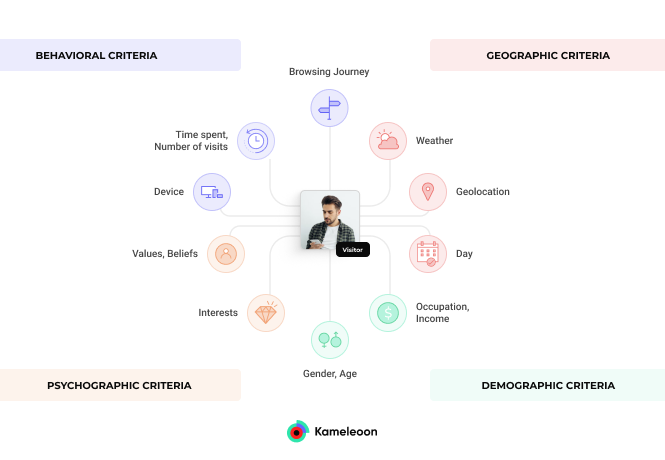
Geographic
This type of segmentation criteria is based on the geolocation of your visitors. It enables you to target your marketing actions based on where your visitors are in the world or on weather conditions.
It is one of the simplest types of segmentation to implement and is often used for location-specific ad targeting and seasonal product recommendations.
Geographic segmentation example
The international sports retailer, Sportmaster, has chosen to segment its audience according to their geolocation and local weather. It suggests products that meet the immediate needs of visitors depending on where they are located.
Customers see two different offers depending on their local temperature: a jacket rated to -10°; and another jacket rated to withstand temperatures of -30°. By customizing their product offering to the location of a user, they can deliver more value and thus, drive more revenue.
Demographic
Demographic segmentation is the most commonly used type of segmentation. The information can be collected easily, and can enable you to quickly target a large potential market.
Demographic criteria most commonly includes:
- Gender
- Age
- Nationality
- Education
- Profession
- Income
- Family situation
While demographic segmentation is easy to obtain and commonly used, it is often considered overly simplistic. For example, it is difficult to assume that all women have similar food interests or all 25 year-olds like the same music because of one shared data point.
Demographic segmentation example
Fashion websites often segment their audience by gender. They use this information to show images, products, and landing pages that are tailored specifically to that gender (ie. male or female).
Psychographic
Psychographic segmentation focuses on the lifestyle of visitors including their interests, personalities, values, beliefs, and opinions.
This is typically the most difficult information to obtain, as you’ll usually need to have your visitors complete a questionnaire or survey. However, it is also considered one of the most useful and reliable ways of segmenting your customer base, as it tends to be more specific.
Psychographic segmentation example
Club Med relies on psychographic criteria to optimize its users’ browsing journey by asking them to choose between “Sea” and “Mountain” when they visit their website for the first time.
They are then segmented into two groups. If they return to the website over the next ten days they’ll be taken directly to the category they chose, and shown products related directly to that category.
Behavioral
Behavioral segmentation is based on how visitors interact with your website or product. Some data depends on their immediate online behavior, while other data depends on their historical behavior (offline) when dealing with the brand.
Below are some examples of each kind of data:
- Online: time spent on the website, pages visited, point of exit, purchase opportunity (urgent or not), purchase attitude, brand loyalty, search engine and device used, subscription type, account or feature usage, traffic source.
- Offline: number of visits, purchase history, and date and amount of latest orders (RFM).
Behavioral segmentation example
Amazon is well-known for their behavioral segmentation. They used customer’s previous purchase and browsing history to recommend items to them that they are more likely to buy in the future.
The different ypes of data to segment audienceS
There are two ways that we distinguish between market segmentation data online.
- Hot data is generated by a user’s visit, such as behavioral criteria (browsing journey, history), contextual criteria (geolocation, weather) or technical criteria (browser/device used).
- Cold data, also known as historical data, can be found in your CRM system. It includes demographic criteria (age, gender, socio-professional categories) or behavioral data from previous purchases (recency, frequency, monetary value or RFM).
Creating effective customer segments is not about using one type of data or criteria. Rather, it is about using a combination of what is available to you, depending on your specific goals and what it is you’re hoping to achieve.
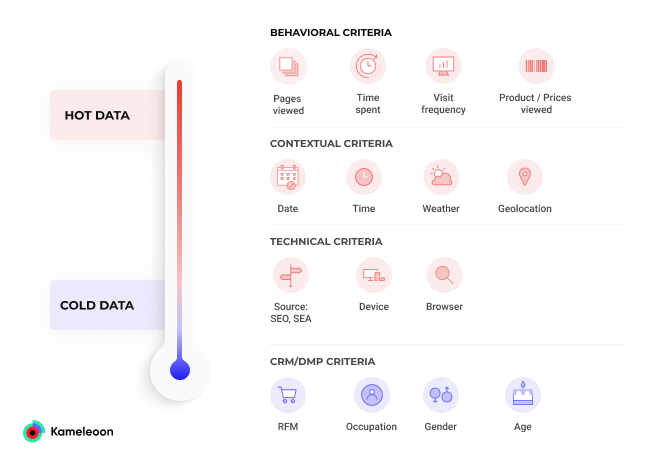
5 What is customer segmentation?
Customer segmentation is a marketing approach that divides a company's customer base into smaller groups based on shared characteristics. These characteristics can include demographics, behavior, interests, and purchasing patterns, as discussed earlier.
Segmenting customers enables businesses to gain a better understanding of their customers' unique needs and preferences, which allows for the tailoring of marketing messages and campaigns to specific groups. This personalized approach increases customer engagement and loyalty and ultimately drives revenue growth.
The process of customer segmentation involves quantitative and qualitative analysis to identify meaningful segments within the customer base. This analysis enables businesses to develop targeted marketing campaigns that directly appeal to the needs and desires of each segment, thereby increasing the chances of achieving their desired business outcomes.
6 What is an example of customer segmentation?
An example of customer segmentation could be a fashion retailer that targets different segments of customers based on their age and fashion preferences.
The retailer can identify three main segments and unique ways to target each one:
- Younger customers (18-34) who are more trend-focused: feature edgier, more trend-driven clothing on their website and social media accounts, along with engaging influencer collaborations.
- Middle-aged customers (35-64) who prioritize quality and comfort: targeted with higher-end clothing made from premium materials and featuring comfortable yet fashionable designs.
- Older customers (65+) who prefer classic and timeless styles: targeted with classic and timeless styles that are built to last and are comfortable to wear.
By tailoring their marketing and product offerings to these different segments, the fashion retailer is able to better meet the unique needs and preferences of each group. This, in turn, leads to increased customer satisfaction, loyalty, and revenue growth for the company.
7 Market segmentation vs customer segmentation
Market segmentation and customer segmentation are very similar concepts, and are often used interchangeably.
The biggest difference between market segmentation and customer segmentation is market segmentation is more broad, whereas customer segmentation is more specific.
Market segmentation could apply to segmenting a market of users, whether they are your customer or not, whereas customer segmentation is often applied to your existing or potential customer base.
Despite these differences, the two share many of the same benefits, characteristics, and types.
8 Methods of segmentation
There are two primary methodologies that are used in segmentation: the “a priori” method and the “post-hoc” method.
The "a priori" method (rule-based segmentation)
The "a priori'' method, also known as rule-based segmentation, consists of manually dividing your audience into homogenous subsets according to predefined criteria.
The criteria can be chosen based on the results of data analysis or research, or by making assumptions based on commonly held beliefs. If you were to create a customer segment based on 50 year-old men living in Canada, you would be using the “a priori” method.
Who is this method for? The “a priori” approach is best for companies with a good knowledge of their market and who can easily identify a priori criteria.
Where do you start? You need to have a good understanding of what is relevant in segmenting your audience to have this method be effective for you.
You also need to have “a priori” information easily available to you. The more detailed your market knowledge, the better chance you have of achieving efficient segmentation.
Example: A clothing brand decides to segment its audience according to the gender and geolocation of its visitors. A woman living in London and visiting the website on December 1st would be presented with winter coats, whereas a man living in Spain who visited the website in the month of June would be shown swimming trunks.
The biggest limitation with this method is it may prove inaccurate, since a woman living in London and visiting the website in December could very well be looking to buy swimming trunks for her son who swims.
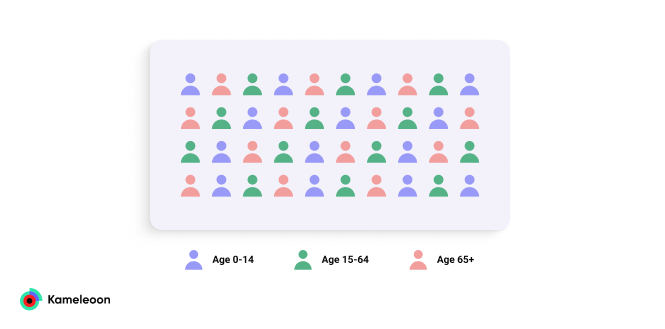
The "Post-Hoc" method (cluster-based segmentation)
The "post-hoc" method, also known as cluster-based segmentation, doesn’t start with criteria or predetermined rules. Instead, you observe the similarities between visitors and then group them together according to those similarities.
This could be:
- Buying behavior
- Visitor data
- Answers to surveys
The criteria is not fixed and can fluctuate widely. The greatest advantage of this approach is that it groups segments together based on actual behavior rather than assumed resemblances.
For example, instead of segmenting men with an interest in cars ("a priori"), you can segment people who have bought tires after being shown a specific promotion and who have stated that they own multiple vehicles.
This will then provide a potential customer segment for the automotive market that is more relevant than a segment built "a priori".
Who is this method for? The “post-hoc” approach is best for companies that have a limited knowledge of their market or are struggling to identify segments using "a priori" criteria.
Where do you start? For this approach, you need to collect information about the visitors to your website (via data analysis, research, surveys, etc.) so that those with similar characteristics can be grouped together.
Example: Rakuten PriceMinister is an online marketplace where individuals and professionals meet to buy and sell.
When a user first visits the site, it has no way of determining if they are a seller or a buyer. No a priori criterion would enable it to clearly identify between these two segments.
For this reason, PriceMinister uses the post-hoc method: thanks to Kameleoon’s predictive algorithms the brand can distinguish between these two segments and adapt its campaigns.
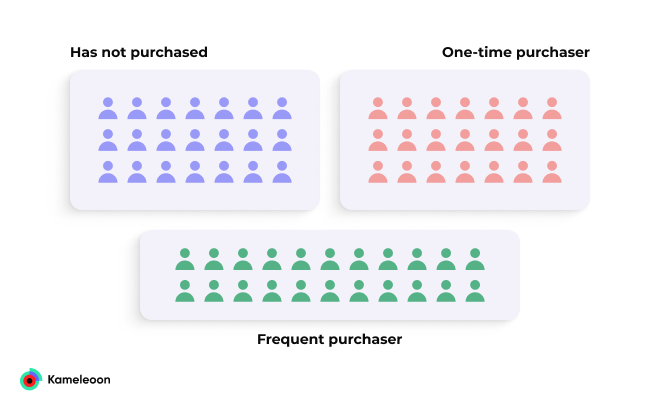
9 Segmentation vs targeting
Although segmentation and targeting are closely related, they are completely separate concepts.
- Segmentation is the act of dividing your market into subsets.
- Targeting is when you create specific marketing materials, products, or user journeys for that particular segment.
The two are often used in tandem with one another in a two-step process, beginning with segmentation. Targeting is often considered an occasional activity (a targeted marketing campaign), whereas segmentation is more evergreen.
10 How to prioritize which segments to target
With so many different ways of segmenting, it can be heard to decide on where to begin. Here are a few factors that will enable you to identify your high-priority segments.
Relevance
First and foremost, your market or customer segment must have strategic value for your company. It is important that the segment you align on is highly relevant to the goal you are trying to accomplish.
Example: Allopneus, an online tire retailer, identified a “power user” segment. This segment represents only 10% of the traffic on their site, but it contributes to a large percentage of the brand's turnover: it is therefore a target with high added value and is highly relevant to achieving their revenue goals.
Profitability
The segment must be profitable in order to be considered valuable. This means you need a clear idea of:
- The number of potential customers making up the segment.
- Their purchasing power.
- Their buying behavior.
By analyzing these elements, you will be able to measure the profitability of the segment. If you identify a segment made up of potential customers, but this only includes a small part of your audience, then it won’t be profitable to pursue this segment.
Example: An online retailer used behavioral criteria to identify customers that are most likely to convert when they have a sale. They named this segment “deal seekers”. They plan to send personalized marketing materials to them with special deals during the holiday season to drive more revenue.
Accessibility
The segment must be accessible, meaning you must be able to reach them - whether by social media, email, search engines, or offline channels like broadcasts or direct mail or more. You also must be able to meet their needs or desires.
Example: A clothing brand wants to appeal to a younger audience. They use TikTok and YouTube to target their segment with personalized ads and offerings.
11 How to segment your market step-by-step
Here are four steps to apply what we’ve learned so far to get started with segmentation.
1. Set a goal
Effective segmentation begins with defining your goal and clearly outlining what it is you’re hoping to achieve. Do you want to:
- Improve your customer retention rate
- Increase your market share in North America
- Reduce your email unsubscribe rate
Your goal will drive how you segment your audience, so make sure it is clearly defined from the beginning.
2. Complete a data analysis
Analyzing the data you have available to you can help you identify interesting patterns and potential ways to segment your audience.
Are there certain segments of customers that drive the most revenue? Are there any interesting patterns you notice about the data right off the bat?
This is where you take in all of the data you have available to you, from hot and cold data, across a variety of segmentation types, to see what you can do with it.
3. Develop a segmentation strategy
A segmentation strategy clearly outlines how you hope to segment your market in order to reach your goal.
For example, let’s say your goal is to increase the stickiness of your product and boost retention. After completing a data analysis, you notice that customers who use the product everyday are 3x less likely to churn.
Your strategy would then be to create a customer segment of individuals who log in to the product at least once a day based on behavioral data in your customer data platform (CDP).
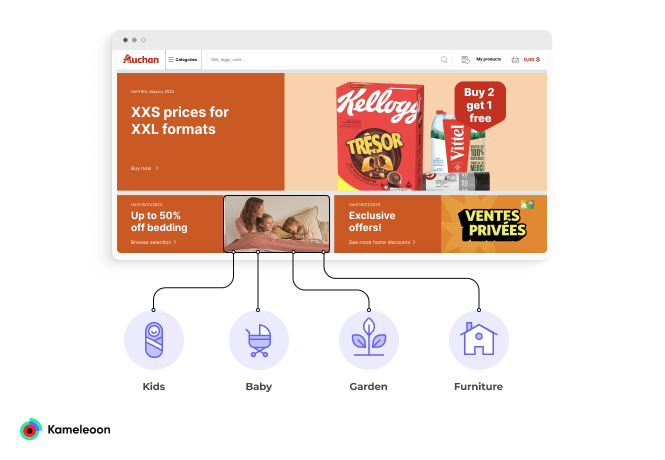
4. Use this segment in your targeting efforts
Once you gather the data and identify a segment, you can then use this segment in your targeting efforts.
These are some of the most common places where we see segments being used for targeting:
- Personalized ad creative and copy: target a segment of users with ad creative and copy that is tied to their previous interactions with your website.
- Landing pages: create landing pages that target a specific demographic of your user segment.
- Email sequences and workflows: create email campaigns that target a specific segment of your users, such as an ecommerce campaign for women under the age 35.
- Segmented product offerings: create different versions of a product or service that cater to specific customer segments, such as a premium version of its product for high-end customers, and a more basic version for budget-conscious customers.
This is where the real magic starts to happen, as you apply what you have learned about your customer to make impactful business decisions.
12 Market segmentation applications and examples
How do you use this segmentation information in practice? Below are a few applications and examples to put your segmentation to work.
Personalized advertising and communications
Using segmentation, you can design your advertising strategy based on the individuals that make up your segments and their needs or wants.
Marketers often use segments to create highly targeted ad campaigns. These often have a far higher ROI than a more broad approach.
Personalized discounts and incentive offerings
Suggest deals, such as discounts or promotional codes, depending on the user’s relationship with your brand.
You could offer unique deals to:
- New visitors to encourage them to become customers.
- VIP customers to thank them for their loyalty.
- Undecided users to convince them to buy.
Product roadmap development
Customer research is an essential part of developing an effective product roadmap. Segmentation can help you better understand your customers and develop a better product suited to their needs.
For example, you can segment your customers based on power users and conduct customer research on how they use the product and what features they would like to see. Then, you can use that information to guide your product roadmap strategy.
Create differentiated products
You may use your customer segment research to develop different products entirely.
For example, Club Med identified two segments of customers in their product research: families and people without children. It used this information to design two different health clubs tailored to the expectations and requirements of each segment.
Perhaps if a one-size-fits-all solution doesn’t work, it’s worth considering how you can create different products tailored to your customer segments.
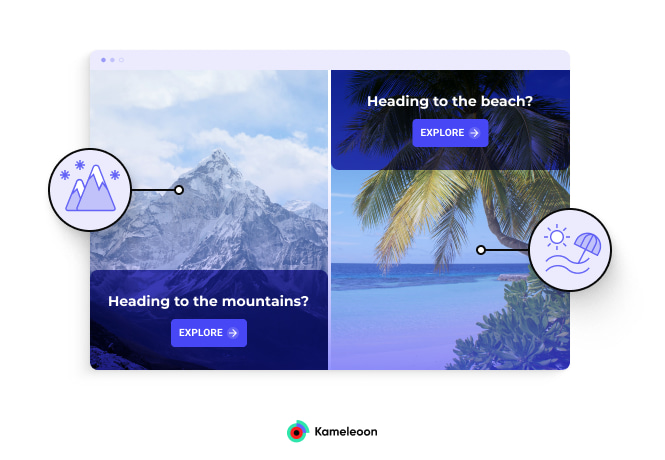
Custom web journeys and browsing
Your website is your storefront. Offer your visitors personalized experiences based on their interests, geolocation, previous history, or even their browsing journey.
You can:
- Switch the image on the homepage according to their age or gender.
- Create personalized banners with individual discount offerings based on previous purchasing behavior.
- Tailor product recommendations based on past purchase history.
- Highlight the categories most often viewed by visitors in that segment.
- Reorganize menu sections according to their preferences.
13 Segmentation with predictive targeting
We have now seen how crucial segmentation is to developing an effective business strategy. Even so, brands still encounter many difficulties implementing segmentation.
72% of marketers said that they had difficulty translating and analyzing data collected about their visitors, while 62% had issues creating content and personalized recommendations for each user.
This is where predictive targeting comes into play.
Predictive targeting involves using a machine learning algorithm to analyze website visitor data and identify which visitors belong to a particular target segment.
By observing visitor behavior and the correlations between them, the algorithm learns how to predict the behavior of each visitor.
Eventually, it determines – with increasing accuracy over time – which visitor belongs to which segment.
Through machine learning, the predictive approach offers superior segmentation, since it is capable of learning from the behavior of visitors to offer them ever more relevant experiences depending on their browsing journey. And it can do this even if it’s their first visit to the website.
Why use predictive targeting?
Predictive targeting is used to identify segments that cannot be found using the “a priori” approach. It is essential when:
- The segmentation criteria are vague, ambiguous, or changeable (I want to know which of my visitors will be influenced by scarcity effects).
- The criteria is too numerous and dissimilar, and impossible to model manually.
In these situations, predictive targeting enables you to identify, with certainty, a greater number of visitors belonging to a segment that you’re seeking to target.
Learn more about AI-driven personalization on Kameleoon.
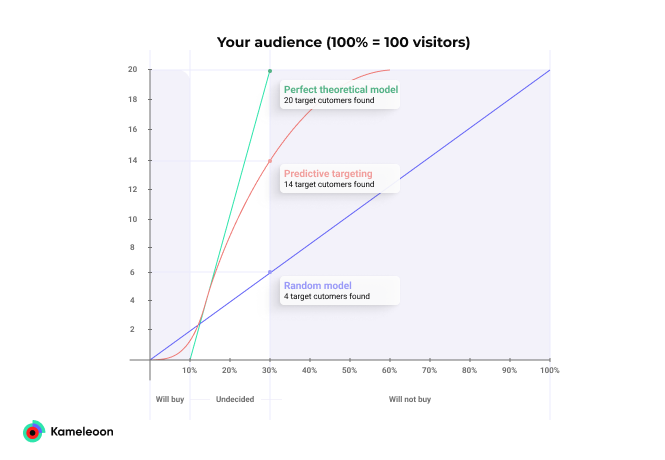
What results can you expect from predictive targeting
Predictive targeting can give you significant results when implemented correctly. Let's take a look at an online tire retailer to see how they use predictive targeting.
Goal: To target “power user” customers and offer them a specific deal. Power users are defined as motorists who cover at least 24,000 km per year or who own several vehicles.
Implementation: With predictive targeting, the algorithm estimates which visitors have the highest probability of belonging to the “power user” segment. It does this by cross-referencing:
- Hot data: browsing journey (brand, quality, budget, tire size), geolocation, source (SEO/SEM), time spent on each page and number of visits.
- Cold data: such as buyer profile (private individual, professional, type of vehicle owned), purchase history or form completion.
Results: This online tire retailer can identify 48% more “power user” customers than through manual segmentation, and has noted an increase of 16% in average cart value.
Predictive targeting can be highly valuable in these instances.Visitor segmentation is thus a key stage in crafting your marketing strategy, and one that requires special attention. It will help you zero in on whom to target with your actions and give you an edge over your competitors.
Market segmentation is the act of dividing your market into identifiable, actionable subsets (segments) that share common characteristics. These might be place of residence, age, lifestyle or even how they behave on your website or app.
Customer segmentation is the process of dividing your customer base into separate and distinct groups based on shared characteristics. These groups can then be used for specific targeting purposes.
The four primary types of market segmentation are geographic, demographic, psychographic, and behavioral. It is important to note that there are an infinite number of ways you can segment your market, including many subtypes within these four categories.
Fashion websites are a great example of segmentation. They often segment their audience by demographics such as gender. They use this information to show images, products, and landing pages that are tailored specifically to that gender (ie. male or female).
A segmentation strategy clearly outlines how you hope to segment your market in order to reach your goal. You may choose to segment based on specific demographics in order to target a customer base or segment based on shared values for your targeting efforts.
You can choose which segment to target based on relevance (how relevant is your segment to the goal you’re trying to accomplish), profitability (how profitable is the segment you’re targeting), and accessibility (is it possible to target this segment and if so, how easy would it be).




